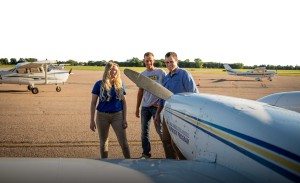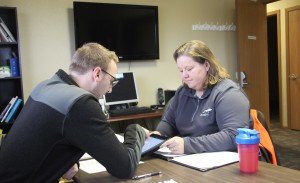When attempting to figure out where she wanted to attend college, Miranda Sullivan ’18 had several items to consider. One of them was her major. Growing up, she had wanted to be a veterinarian, but a discovery flight switched her mindset to aviation.
The South Dakota State University aviation program swayed the Orleans, Indiana, native to select SDSU and compete four years on its equestrian team. With her bachelor’s degree in hand, Sullivan is now working on a master’s degree in curriculum and instruction while working as a flight instructor.
“I decided to pursue a master’s after getting my bachelor’s so I had more opportunities within the aviation industry,†she said. “I would love to both fly for a major airline and teach. I enjoy the educational side of aviation immensely and would love to continue educating future aviators.â€
That information is what Cody Christensen wants to hear. Christensen, who started leading the program in 2014, said graduates have worked as SDSU flight instructors for six months to one year before being hired by a regional airline. SDSU has 25 flight instructors for its nearly 150 students.
“When we saw the growth potential that was possible in the industry, we started training more flight instructors to meet the demand,†said Christensen, an assistant professor. “We want to make sure we’re providing the safest, best prepared students we can while still being as cost-effective as possible with the student dollars.â€

Lisa Strohschein ’03 helps Jordan Steinle prepare for an interview by talking about his approach to a Kentucky airport. Strohschein, president of the aviation program’s industry advisory board, likes working with students when her schedule with UPS allows.
The program has nearly doubled in the past five years. Lisa Strohschein ’03 credits Christensen and the other faculty members for the growth.
“SDSU puts out great students because Cody and the guys who run it are unbelievable,†said Strohschein, who is president of the program’s industry advisory board. “The time and effort Cody and the others put in to make the program better is amazing. They truly want the students to succeed.â€
Christensen thinks the program could continue to grow.
“I think we could see another doubling. We are growing because we are providing the best pilot population for the state of South Dakota and the surrounding region we can,†Christensen said. “However, our biggest restriction is not having a place to house our aircraft. We need another hangar.â€
Plans for a new hangar have been developed. Christensen, the College of Education and Human Sciences and the SDSU Foundation are pursuing avenues to finance it.
“We still want to be a smaller program and one that knows our students as individuals, one that takes care of our students and their career aspirations,†he said. “If students want to work at Delta or United, they will need a four-year-degree.
“We’re accredited and a one-stop shop to go to the regional airlines, which lead into the major airlines.
“This growth translates into a better return on investment for our students the last few years,†Christensen continued. “For example, six years ago, when a student would walk into my office and ask, ‘Should I be an engineer or a pilot?’ It would be a tossup just considering the first-year pay difference. Now, pilots can walk out of here and make $65-70,000 and move into the mid-six figures fairly quickly in their careers.â€
While the industry is in a growth mode, Christensen and others have conducted numerous outreach activities. In addition to meeting junior high students, SDSU has put a simulator in a trailer and encourages individuals to attend its ACE Camp.
“Students get to see teachers, nurses and a few other professions as viable careers because they see and get to talk to people in those professions. Since there aren’t that many pilots out there, they might not talk to many or see them operate,†Christensen said. “We use those opportunities to show the students our mobile simulator, teach them about the aviation profession—whether that’s aviation management, flight instruction or maintenance management and how you can be an aviation professional in South Dakota.
“It’s been really successful,†he continued.
Sullivan agrees.
“I love the freedom and endless possibilities aviation gives me,†she said. “I’m so glad I picked it.”
-Matt Schmidt







